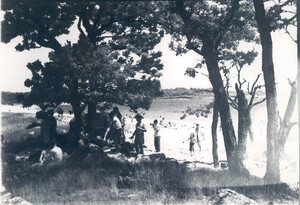Because marine organisms live in a variety of environments, collecting happens in a variety of environments. Collectors look for specific organisms in deep water, on beaches, under docks, in coves and more. In order to find specimens, collectors need to know where to look. This proves incredibly tricky over seasons and years as the landscape and ecosystems shift, and ultimately requires a very heavily guarded oral tradition. Each collector has his or her secrets about where to find things. These are important because there are no guarantees, even day to day. As Gemma Captain Bill Klimm once said “a lot of times you go back to the same spot and you say, ‘ah I know where they are now’, but they have tails and they can swim, and they’re gone”.
 This remains true today, when asked how they know where to look for a particular organism, the head of the Marine Resources Center, Dave Remsen states “It’s an oral tradition. The collectors know. That’s why they are so valuable. Gemma captain Billy Klimm is a commercial fisherman, so he knows how to operate the boat, but he also knows where to go and how to bring the animals back alive. Lots of people can go out and collect squid, if they can find them, for calamari. But to bring them back alive requires special handling, equipment, and know-how. Also, the landscape isn’t stable: The animals move around; habitats change over time. We have to stay on top of that. We need a presence out there all the time, looking around, scouting”.
This remains true today, when asked how they know where to look for a particular organism, the head of the Marine Resources Center, Dave Remsen states “It’s an oral tradition. The collectors know. That’s why they are so valuable. Gemma captain Billy Klimm is a commercial fisherman, so he knows how to operate the boat, but he also knows where to go and how to bring the animals back alive. Lots of people can go out and collect squid, if they can find them, for calamari. But to bring them back alive requires special handling, equipment, and know-how. Also, the landscape isn’t stable: The animals move around; habitats change over time. We have to stay on top of that. We need a presence out there all the time, looking around, scouting”.
In addition to needing to know the specimen’s environment for collecting, it can also be useful to know the details of this environment for the research. Since the MBL opened, many collectors and scientists have argued that it is crucial for a researcher to know the organism being studied in detail. This means knowing what sort of microenvironment it is found in, when it breeds, when it feeds, and more. It’s easy for a scientist to become disconnected from these details, as long as the organism provides a basic model that helps the researcher answer their particular research questions. This disconnect, however, has been largely frowned upon at the MBL, “a true scientist must know his beast” Ernest Everett Just insisted.
- Dolgin, Elie, “The Squid Collector,” http://www.nature.com/news/not-your-average-technician-1.16785
- “John J. Valois, Obituary” http://www.mbl.edu/obituaries/john-j-valois/
- “John Valois, Longtime Specimen Collector and Naturalist, Honored at the Marine Biological Laboratory,” July 12, 2011, http://hermes.mbl.edu/news/press_releases/2011/2011_pr_07_12.html
- The Collecting Net Spring 2006, Vol. 2, No. 1 http://hermes.mbl.edu/publications/collecting_net/2006/06_01net06.html Accessed on July 16, 2015.
- Maienschein, Jane, and Ruth Davis. 100 years exploring life, 1888-1988: the Marine Biological Laboratory at Woods Hole. Jones and Bartlett Publishers, 1989.
- “MBL Moment with Dave Remsen,” MBL Catalyst January 2014, p 12-13. http://www.mbl.edu/wp-content/uploads/2013/07/Catalyst.Winter13-14.web_.pdf Accessed on July 16, 2015.
- Williams, Wendy. Kraken: The Curious, Exciting, and Slightly Disturbing Science of Squid. Abrams, 2011.

